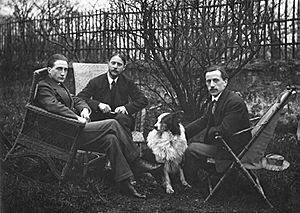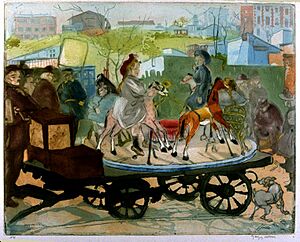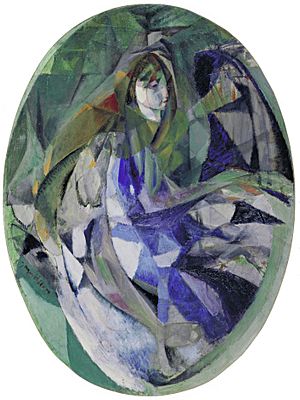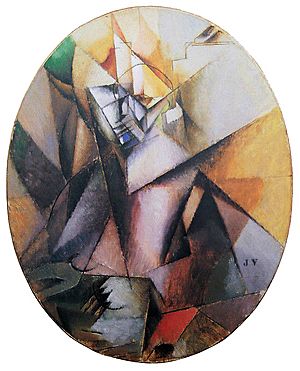Jacques Villon facts for kids
Jacques Villon (born July 31, 1875 – died June 9, 1963) was a famous French artist. His real name was Gaston Duchamp. He was known for his Cubist and abstract paintings and prints.
Contents
Early Life and Family
Gaston Duchamp was born in Damville, France. He came from a family that loved art. His grandfather, Émile Frédéric Nicolle, was a successful businessman and artist. He taught Gaston and his brothers and sister about art.
Gaston Duchamp had three younger siblings who also became artists:
- Raymond Duchamp-Villon (1876–1918), a sculptor.
- Marcel Duchamp (1887–1968), a painter, sculptor, and writer.
- Suzanne Duchamp-Crotti (1889–1963), a painter.
In 1894, Gaston and his brother Raymond moved to Montmartre in Paris. This area was a lively place for artists. Gaston started studying law at the University of Paris. However, his father allowed him to study art too, as long as he kept up with his law studies.
To stand out from his famous brothers, Gaston Duchamp chose a new name. He called himself Jacques Villon. This name was a tribute to the medieval French poet François Villon. In Montmartre, Jacques became more interested in art than law. For the next 10 years, he worked on graphic art. He drew cartoons and illustrations for Paris newspapers. His work appeared in the satirical newspaper Le Courrier français. He also created a few advertising posters in the soft style of the Belle Epoque.
In 1903, he helped set up the drawing section for the first Salon d'Automne art show in Paris. He later studied art at the Académie Julian in 1904-1905. At first, his art was influenced by artists like Edgar Degas and Henri de Toulouse-Lautrec. Later, he explored Fauvism, Cubism, and abstract impressionism.
Moving to Puteaux and New Art Styles
By 1906, Montmartre was very busy. Jacques Villon decided to move to Puteaux, a quiet area outside Paris. There, he spent more time on drypoint printmaking. This is a special technique that creates dark, soft lines on paper. He worked closely with other printmakers like Manuel Robbe to improve his skills.
Because he was away from the busy art scene in Montmartre, his art was not well known for some years. He was also a modest person, which kept him out of the spotlight.
In 1911, Jacques Villon and his brothers Raymond and Marcel started a discussion group at his home. Other artists and critics joined them, including Jean Metzinger, Albert Gleizes, Francis Picabia, Robert Delaunay, and Fernand Léger. This group became known as the Puteaux Group, or the Section d'Or. Villon helped the group choose the name Section d'Or. This name came from the golden section in classical mathematics.
Their first art show, Salon de la Section d'Or, happened in October 1912. It featured over 200 artworks by 31 artists.
In 1913, Villon created seven large drypoint prints. In these, shapes broke into shaded, pyramid-like forms. That same year, he showed his art at the Armory Show in New York City. This show helped introduce modern European art to the United States. Villon's works were popular, and all his art sold. After this, his reputation grew. By the 1930s, he was more famous in the United States than in Europe.
Awards and Recognition

Jacques Villon had an art exhibition in Paris in 1944. After this, he received many honors at international art shows. In 1938, he was made a Chevalier (Knight) of the Legion of Honor, a top French award. He was promoted to Officier (Officer) in 1947.
In 1950, Villon won the Carnegie Prize. This was the highest award for painting in the world at the time. In 1954, he became a Commandeur (Commander) of the Legion of Honor. The next year, he was asked to design stained-glass windows for the cathedral in Metz, France. In 1956, he won the Grand Prix at the Venice Biennale exhibition.
One of Villon's biggest achievements was creating a unique way to show Cubism in printmaking. No other printmaker, not even Pablo Picasso or Georges Braque, could do this in the same way.
Jacques Villon died in his studio in Puteaux.
In 1967, his last surviving artist brother, Marcel, helped organize an exhibition in Rouen. It was called Les Duchamp: Jacques Villon, Raymond Duchamp-Villon, Marcel Duchamp, Suzanne Duchamp. Parts of this family art show were later displayed at the Musée National d'Art Moderne in Paris.
Many important museums around the world have Villon's art in their collections. These include the Museum of Modern Art in New York City, the National Gallery of Art in Washington D.C., and the Art Institute of Chicago.
Art Market
In May 2004, one of Villon's oil paintings from 1913, called L'Acrobate, was sold at Sotheby's. It sold for $1,296,000 (US dollars). This shows how valuable his art is.
See also
 In Spanish: Jacques Villon para niños
In Spanish: Jacques Villon para niños







